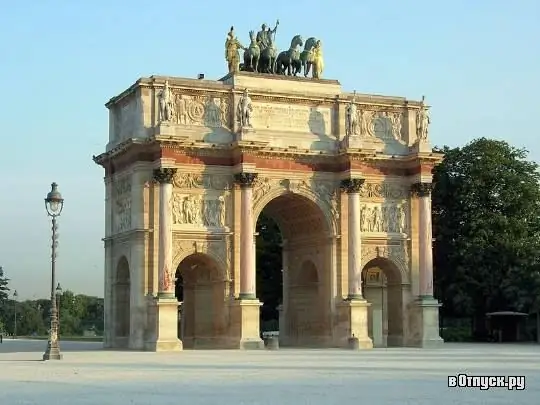
Description of the attraction
The Arc de Triomphe at Place Carrousel is the first of three famous structures that stretch a distinct optical axis across Paris. At any point on this axis, you can see the arches lying on a nine-kilometer straight line - Carrousel, Triumphal on the Place Charles de Gaulle and the Greater Défense district.
The arch in front of the Tuileries Palace was ordered to be built by Napoleon Bonaparte in memory of his own victories in 1806-1808. The project was entrusted to the architects Charles Percier and Pierre Fontaine, whom the emperor trusted: they were the trendsetters, the leading masters of the Empire style. This style embodied a sense of imperial might and military strength. It was ideal for celebrating the success of the empire.
In their work on the project, Persier and Fontaine were inspired by ancient examples: the Romans were the first to build the triumphal gates for their victors. The Arch of Titus (81), the Arch of Septimius Severus (205) and the Arch of Constantine (315) are known in Rome. Napoleonic architects took the arch of Septimius Severus as a model, but somewhat reduced the size (height 19 meters versus 21 meters in the Eternal City). However, the Parisian building turned out to be no less solemn and ceremonial.
The facades of Carruzel are richly decorated with sculptures. The subjects for the compositions were selected by Dominique Vivant-Denon, a talented amateur Egyptologist who was appointed director of the Louvre by Napoleon. The reliefs depict Napoleon's entry into Munich and Vienna, the Battle of Austerlitz, the Congress of Tilsit, the fall of Ulm. The arch is also decorated with the heraldry of the French Empire and the Italian Kingdom.
The arch was crowned by the quadriga of St. Mark, made of gilded bronze. It is believed that Lysippos himself sculpted it in the 4th century BC. NS. At one time, four bronze horses adorned the hippodrome of Constantinople, during the Fourth Crusade, the Doge Dandolo took it to Venice and installed it at the Basilica of San Marco. Napoleon, having conquered Italy, took, in turn, the quadriga to France to decorate the Carrusel arch with it. After the fall of Bonaparte, the French returned the sculpture to the Italians. Now on the arch stands a composition depicting the triumph of the Bourbons (authors - François-Frédéric Lemo and François Joseph Bosio).






